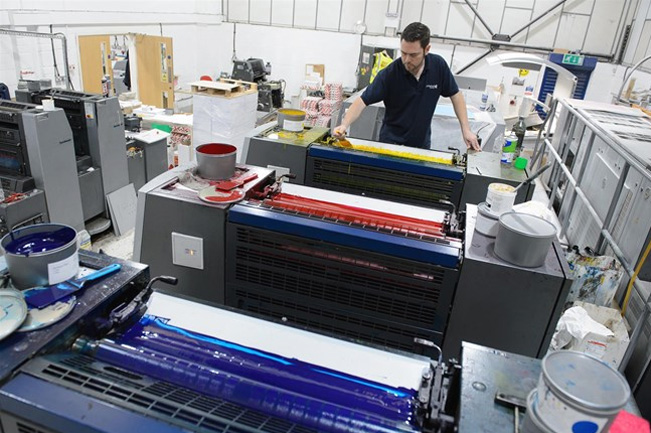The Perks of Using litho printing for Promotional Prints
The Perks of Using litho printing for Promotional Prints
Blog Article
A Comprehensive Overview to Comprehending Litho Printing Techniques
The globe of litho printing, a technique stemming from the late 18th century, is an interesting blend of background, science, development and art. This comprehensive overview will certainly decipher the intricacies of this printing technique, from the composition of litho inks to the challenges encountered in modern-day applications. As we venture right into the complexities of lithography, the relevance of automation and sustainability in ensuring its future relevance comes to be increasingly clear. Stay with us as we trip right into the captivating world of litho printing.
The Historical Evolution of Litho Printing
The historic trajectory of litho printing, an essential innovation in the world of communication, is a fascinating story of human resourcefulness. Birthed in the late 18th century by Alois Senefelder, this method was initially an affordable approach of publishing theatrical works. Lithography, stemmed from the Greek words for 'rock' and 'to create', utilized a smooth rock surface area to transfer pictures onto paper. The process evolved with the advent of the rotary press, which considerably raised performance (litho printing). In the 20th century, the development of offset lithography revolutionized the industry, enabling for mass manufacturing of premium prints. Each stage of litho printing's evolution showcases humanity's relentless pursuit of effectiveness and quality in aesthetic interaction.
Decoding the Scientific Research Behind Litho Printing Inks
Progressing in the exploration of litho printing methods, the emphasis now moves to the science behind litho printing inks. The composition of these inks, their drying out process, and shade mixing methods create the backbone of this intricate art form. Comprehending these components is important to mastering the craft and achieving the wanted print results.
Composition of Litho Inks
In lithographic printing, the basic function of litho inks can not be overemphasized. The structure of litho inks differs depending upon its objective, yet normally, they include 2 primary elements - pigments and cars. Pigments, the color-providing aspects, are finely ground particles suspended in the lorry, a liquid that brings the pigment onto the printing surface. The lorry is an intricate combination of resins, oils, and solvents, which affect the ink's drying time, adhesion, and gloss. In addition, different ingredients are present to improve particular residential or commercial properties like circulation, drying out, and resistance to environmental impacts. Each element plays a crucial component in the last print's quality, making the specific formulation of litho inks an elaborate science.
Ink Drying Process
From the composition of litho inks, attention transforms to the remarkable procedure of ink drying out. Two main techniques are used in litho printing: oxidative drying and absorption. Absorption, on the other hand, involves the ink seeping into the paper fibers, which is a quicker procedure yet can lead to much less dynamic shades.
Shade Mixing Methods
While the drying process plays a vital duty in litho printing, the scientific research of shade blending strategies holds equal relevance. The science behind litho printing inks additionally takes into account the transparency of the ink, which influences how colors overlay and mix.
The Art and Layout Elements in Litho Printing
Litho printing breathes life into art and design through its unique elements. Litho printing suits a selection of colors, making it possible for musicians to produce dynamic and vivid prints. This mix of precision and flexibility makes litho printing a preferred choice for numerous artists and developers.
Modern Applications of Litho Printing Methods
Litho printing methods have actually located considerable usage in the modern-day industrial sector. Its impact and significance remain to expand with the advent of brand-new innovations and modern technologies in the area. This section will certainly check out these modern applications and the transformative function they play in the printing sector.
Commercial Litho Printing Uses
Litho printing continues to be a crucial part of the commercial industry. read more High-volume printing tasks, such as the manufacturing of publications, papers, and product packaging, depend on litho printing for its ability to supply remarkable photo top quality and price efficiency. Litho printing likewise offers a wide color spectrum, superior to that of digital printing.
Technologies in Litho Printing
Pressing useful site the boundaries of standard strategies, modern-day advancements have fueled a host of innovations in litho printing. One popular development is digital litho printing, which incorporates the merits of electronic modern technology with litho's top notch output. These advancements underscore the enduring importance of litho printing in the modern globe.
Discovering the Process of Litho Printing: Action by Action

Difficulties and Solutions in Contemporary Litho Printing

Regardless of the precision and practice that litho printing proudly promotes, it is not without its collection of modern difficulties. linked here One of the most prevalent problems consist of the high first configuration price, difficulty in printing variable information, and ecological concerns as a result of chemical usage. Options are emerging as technology develops. Digital litho printing enables affordable brief runs and easy personalization, addressing the concern of variable data. Environmentally-friendly inks and more secure plate-making procedures reduce ecological concerns. Furthermore, improvements in automation have actually reduced labor expenses, better democratizing the lithography process. Therefore, while there are challenges, the litho printing industry is proactively adjusting to meet them head-on, guaranteeing its relevance in the future.
Verdict
In conclusion, litho printing, with its abundant history and scientific intricacies, holds a substantial place in the print sector. The future of litho printing pivots on its ability to adjust to these altering needs, affirming its long-lasting worth in an evolving market.
Report this page